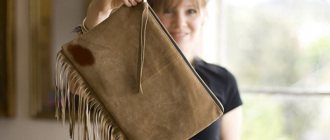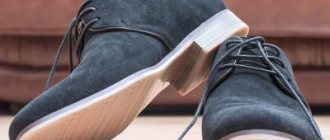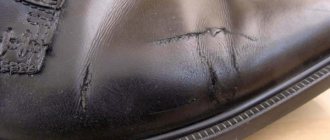Suede shoes have always been popular even among the most discerning fashion connoisseurs. Products made from this material are distinguished by elegance, softness, grace and special style. However, suede, which is delicate and sensitive to external factors, requires especially careful care. There are several tips on how to wash suede shoes so that the service life and appearance of the product are preserved for a long time.
Can suede shoes be washed?
Suede material does not withstand moisture well. Therefore, it is recommended to avoid frequent contact of the product with water. But in some cases you can’t do without washing. The dirt can be so severe that a standard brush alone will not cope. Washing can be done by hand or in a washing machine. Products made from artificial material are not too fancy, so the delicate mode in the machine is suitable for them. It is better not to wash shoes made of natural suede on automatic mode.
Models made of soft fleecy leather require proper care.
But unless absolutely necessary, you should not use washing or large amounts of water on suede.
Features of suede
Suede fabric on a natural basis is obtained by tanning and impregnating the skin of calves, sheep, goats or deer with a special composition. This is a thin and elastic material with a fleecy and delicate surface, but at the same time suede is characterized by wear resistance and durability. This fabric allows air to pass through well, retains heat for a long time, and is lightweight and soft. This material never gets wet through.
However, natural suede has disadvantages:
- it costs expensive;
- quickly becomes dirty and dusty;
- shoes made of such material cannot be worn in rainy weather, since exposure to moisture negatively affects its appearance;
- special care products are required.
Artificial suede is a fabric with fibers, imitation of natural leather. It is characterized by less durability and strength, but with good care it can have an attractive appearance for a long time. This material repels dust well, is easy to clean from dirt, but does not allow air to pass through and does not tolerate moisture well.
Cleaning products for suede (artificial and natural)
There are many ways to clean suede shoes at home. They are divided into specialized and folk. The choice of the appropriate product depends on the nature of the dirt and the condition of the shoes as a whole.
Neglect of preventive maintenance and improper removal of dirt can quickly render even a high-quality product unusable.
Foam cleaner
The foam cleaner is suitable not only for natural materials, but also artificial ones. It not only allows you to deal with difficult stains, but also restores the color of the product and raises the pile. When using, you need to take a bottle of cleaner and shake it. Then the product is evenly applied to the surface of the shoe and left for several minutes. Remove any remaining cleaner with a brush. The simple steps listed above are enough to give your shoes a presentable look.
Foam, aerosol, and spray are actively used in dry cleaning to effectively clean shoes.
Note! Foam cleaners are expensive. But their consumption is economical. Therefore, one bottle will last a long time.
The advantages of the product are the ability to remove persistent traces of dirt, remove unpleasant odors, gently acting on the pile without harming it. If it was not possible to obtain the desired result the first time, the procedure is repeated. It is important to carefully follow the instructions for use. If you leave the foam on the surface for half an hour, it will simply dry out and there will be more problems with your shoes.
Foam shampoo removes dirt, salt and water stains, deepens the color of products and cares for them.
Folk remedies
Various available tools can help deal with stains. Among the popular ones it is worth highlighting the following:
- Vinegar. The product copes well with wax marks on the pile. 9% vinegar will do. It is combined with water in a ratio of 1:5. After mixing in the resulting solution, moisten a clean rag and use it to treat problem areas;
- Starch. Suitable for removing greasy marks on surfaces. Starch is poured onto problem areas of shoes and left for an hour. Remove the powder with a brush. Starch can be replaced with baby powder;
- Eraser. This is a special product that allows you to literally erase traces of dirt from the surface. You can purchase such a product at a shoe store.
Other chemicals
Stores offer a wide range of different shoe care compounds. The main thing is to choose the right product correctly. It is not recommended to save much on such products. Alcohol and acetone can easily remove stains, but they easily damage the surface of the product. After this procedure, shoes become unusable.
The main disadvantages of suede are its high maintenance requirements and sensitivity to moisture.
Before using the selected composition, it is important to carefully study the manufacturer’s instructions and act strictly according to them.
Note! Do not use fabric stain remover. Such products are not suitable for suede material.
To improve the properties of the material, special sprays, impregnations that protect against water, dyes and reducing agents are used.
Cleaning Brushes
The key difference between suede brushes is the material they are made from. They can be divided into the following types:
- Crepe. Consists of steel fibers at the bottom and rubber strips at the top. The lower part allows you to get rid of stains and dust. The upper, softer part removes abrasions. The brush also has a nylon insert necessary for aligning the bristles;
- Double made of metal. Quite coarse and often used to get rid of soil from the surface of a product;
- Universal. The product may have natural or artificial bristles. Allows you to remove dirt, even if the stains are serious;
- Combined. Has several working surfaces. In addition to suede, it is suitable for cleaning nubuck or velor;
- Triangular. The sides are made of rubber, the main surface is made of nylon pile. The reverse side is made of rubber. Allows you to get rid of heavy stains, dust and soil residues;
- Eraser. It has already been noted that such a brush is made in the form of an eraser and allows you to erase dirt;
- Sponge. Not only does it allow you to get rid of dirt, but it is also convenient for removing residual cleaning products from the surface and applying paint.
The quality of cleaning depends not only on the correct type of brush, but also on its skillful use. The following recommendations should be followed:
- The chamois and brush must be dry;
- A rubber brush with rubberized inserts copes well with dirt;
- If the dirt is not completely removed with the soft part, you should treat the area with the hard side of the brush;
- A stiff brush should be used as carefully as possible. The surface must be carried out carefully, without injuring the suede;
- For areas where the seam is located, it is recommended to use a special roller brush.
Immediately after purchase, suede shoes are cleaned with a special brush and treated with a water-repellent aerosol.
We treat moisture with improvised means (folk methods)
If you have a lot of broken candles, oil, beeswax or paraffin at home, find out how to properly treat leather shoes for free.
Linseed oil, wax/paraffin
Melt 30 g of wax or paraffin over low heat, pour 10 g of linseed oil into it, mix thoroughly. Apply the warm solution with a wool patch to areas of the skin in contact with moisture.
Paraffin is similar in properties to wax. It combines well with oils and protects leather shoes so as not to get wet or damage the shoes. You can use it instead of wax.
Glycerin, turpentine, beeswax, fish oil
The ingredients for preparing the drug must be liquid. Before preparing the product, make sure that the wax is melted over low heat.
Necessary:
- turpentine and glycerin (20 g each);
- fish oil (40 g);
- wax (10 g).
Mix the ingredients in equal proportions and apply to the surface of the skin. Glycerin, as an ingredient, prevents warping of the skin and protects against cracks in severe frosts.
How to clean suede shoes at home
Cleaning methods may vary depending on the color of the suede and the nature of the dirt. Therefore, it is worth understanding all the nuances of the procedure.
Dry cleaning is optimal, as well as minimal spot wetting with a damp sponge.
Light suede
Light-colored shoes suffer more from outdoor pollution. Therefore, it is first recommended to remove all traces of dirt that have dried. Then add a few drops of ammonia and a teaspoon of soda to a glass of skim milk. After thoroughly mixing, the composition is applied to the contaminated areas using a sponge. After wiping everything, remove any remaining product. Leave the shoes to dry and use a brush to lift the pile. It is recommended to first test the resulting composition on a small area of suede.
The fleecy surface is easily painted, so you should purchase separate tools for dark and light shoes.
Sneakers
Shoes can be easily cleaned of dirt using specialized products and shampoos. But if you don’t have such compositions at hand, you can use a folk recipe. It is enough to combine ammonia with soap solution in a ratio of 1:4. After mixing, treat stains on suede sneakers with the resulting solution. Then gently wipe the area with clean water. Be sure to dry your sneakers. This should be done naturally; suede does not tolerate exposure to high temperatures and sunlight. This recipe is perfect for light suede.
Splashes and any other contaminants are removed only after the shoes are completely dry.
Boots
If your boots are heavily soiled, you should entrust the cleaning process to professionals. Such dry cleaning can restore the presentable appearance of boots. But you can try to cope on your own. The above recipes are suitable for processing suede. You can also use a brush and treat the entire surface of the boots with it.
It is necessary to regularly treat with special means and clean the pile.
Shoes
If your suede shoes get dirty, it is recommended to dry the shoes first. Then you should try to remove traces of dirt using a suitable brush. It is recommended to move in the direction of the natural position of the pile to maintain its smoothness. Then you can use one of the folk recipes. In addition to dissolving ammonia in a soap solution, you can add it to dishwashing detergent.
Suede shoes, shoes and boots should be stored in a place protected from direct sunlight.
After mixing, foam forms, which is applied to problem areas. After removal, wipe the surface with a dry cloth. Then add a teaspoon of vinegar to a liter of water and treat the surface of the shoes with the resulting solution using a rag. The prepared composition allows you to make the damaged parts smoother. At the end of the procedure, the shoes are dried.
Drying suede boots correctly
If you had to wash your suede shoes with water, you need to dry them properly. Natural drying is extremely important for such material. If you try to speed up this process, the suede will become rough and hard.
To ensure your shoes dry properly, you need to follow these recommendations:
- It is forbidden to dry suede products with a hairdryer, near an open fire source or near a radiator.
- Wet boots should be dried in a well-ventilated area, avoiding direct sunlight.
- Shoes should also be dried from the inside. For this purpose, crumpled newspaper is placed in it, which is changed as needed. This method will be effective if the boots are wet through.
The suede product needs to be dried for about 20 hours. As a last resort, you should use a hairdryer. In this case, the lowest power is used, and the device itself must be kept at a distance of 20-25 cm from the surface of the shoe.
How to remove white stains
You can often notice white stains on suede shoes. This problem is especially relevant for dark colors, where this nuisance is more pronounced. Among the effective remedies against white marks it is worth noting:
- Eraser. A special brush in the form of an eraser allows you to get rid of stains. First, the surface is treated with the smooth side of the brush. Then a soft part is used to sand away the dirt, eliminating streaks. If you don't have a shoe eraser at hand, you can try replacing it with a school eraser. It's better to choose a light one. You need to rub the product with it, and then hold the shoes over hot steam for several minutes. Do not lower the product too low. Hot steam allows you to lift the pile;
- Rye bread. First, it is dried in the oven and the resulting product is used to treat shoes. Finally, the product is treated with a brush to remove bread crumbs.
Processing is carried out with gentle movements, against the pile.
The recipes described above with vinegar and ammonia also allow you to get rid of light stains.
Washing methods
There are several methods for washing suede products: steam, hand and machine wash.
Washing suede by hand
Washing a suede dress (as well as a skirt, jacket, shoes) at home is difficult. The easiest way out is to take your soiled outfit to the dry cleaner. But you can wash the product yourself. It is best and safest to do this manually, following certain rules.
- When washing suede items, do not soak the items for a long time.
- You need to wash suede quickly, minimizing the time of active exposure of the suede to detergents and water.
- The dress is washed separately from any other items.
- Washing is done in a large basin or in a bathtub.
- The water temperature should not exceed 30 degrees.
- The detergent must be completely dissolved, eliminating the appearance of flakes or lumps.
- The suede dress is immersed in soapy water and treated with a soft sponge or brush.
- During washing, rough friction, strong compression or other deformation of the fabric should be avoided.
- The suede product is allowed to drain at the bottom of the bathtub or basin, the water is drained, then rinsed in running water several times until the water becomes absolutely clean and transparent.
- At the end of the wash, add 1 tablespoon of vinegar or 1 teaspoon of ammonia to the water.
Hand washing will perfectly remove dirt from a dress made from natural suede or velor, or from artificial substitutes. Using this method, you can easily clean suede clothing with a synthetic, silk or cotton lining.
Machine
It is better to avoid machine washing, preferring hand or regular dry cleaning. But if you decide to resort to this method of washing, you should follow several rules:
- Before washing a suede product in a drum machine or machine, read the label and make sure whether it can be washed in this way.
- It is recommended to wash suede dresses only in machines of the latest generations, with the least “traumatic”, the most gentle mode for especially delicate fabrics - for example, the “Hand Wash” mode.
- Machine washing will require a special detergent for “finicky” suede. You shouldn’t save money and choose “cheaper” ones so as not to spoil your favorite thing.
- The temperature for heating water in the machine should not be higher than 40 degrees, or better yet 30.
- It is better to turn off the “Spin” function and not use it, but dry it as if by hand, laying it on sheets or hanging it on a wardrobe hanger with sloping shoulders.
Steam cleaning
A suede dress or other items made from this material can be cleaned using hot steam. This procedure will be very easy if there is a steam generator in the house. It is enough to direct a stream of steam at the dirt or worn-out shiny area of the fabric, and then follow the steam treatment over the surface of the contaminated fabric with a special rubber brush for cleaning suede, velor, corduroy, and velvet.
If there is no steam generator, you will have to hang the dress over a pan of boiling water or use an iron with a “vertical steam” function. After steaming, smooth out the pile in shiny areas.
How to remove salt
In winter, suede shoes often suffer from the effects of salt. You can remove traces of it with a brush. But if this does not help, it is recommended to hold the shoes over hot steam for several minutes, avoiding getting too wet. Then the suede is wiped with a dry cloth. Using a brush, lift the pile. Then the sponge is soaked in vinegar and the surface is wiped. Finally, the product is dried.
A special toothbrush can be replaced with a toothbrush that has been better used, since it will become sufficiently soft.
You can also get rid of traces of salt using a special eraser. It is enough to treat the surface with it and remove its remains. This will remove traces of salt from the surface.
Removing stains from suede
If you don’t have time to wash your dress, but the stain spoils the whole look and you urgently need to clean it, you can use a steam generator . To do this you will need a special attachment for cleaning suede .
If there is no steam generator, and the dress needs to be refreshed and given a well-groomed look, then you can arrange a “steam room” in the bathroom. To do this, you need to pour boiling water and place the product in a vertical position on a hanger. The steam will refresh the look of the product, and only the final touch remains - combing the suede fibers with a brush specially designed for this.
DIY Yoga Mat Bag
DIY patchwork bags
How to properly care for suede shoes
To make it easier to get rid of dirty marks, shoes must be carefully and regularly looked after. This way you can prevent the formation of stubborn, complex stains. Before storing the product until the next season, be sure to dry it and remove all stains. Then special protective agents are applied to the surface. If there are abrasions, they are painted over. To maintain the shape of the shoes, lasts are placed inside. Do not place shoes in a plastic bag. It is better to choose fabric.
Professional products for removing dirt from suede are sold in shoe stores.
Special protective impregnation can be used not only when shoes are put away for storage. The composition will not be able to completely protect the surface from contamination, but it will prevent serious contamination. It is recommended to apply the product before leaving home.
Suede is a rather capricious material and requires careful care.
It is important that there is no complete protection of suede from dirt. But steps can be taken to reduce the likelihood of serious deterioration in product quality. It is also recommended to purchase a small brush and carry it with you. If you find a stain, you can carefully clean it so that the dirt does not soak into the deeper layers of the fabric. Regular and careful care of suede products will extend their service life, maintaining quality and attractive appearance.
Why do shoes get wet?
Most often, water gets into shoes if low-quality material is used for sewing, and microcracks or defects appear on the sole.
This usually happens with cheap, low-quality shoes.
Note: pay attention not only to the appearance of the shoes, but also to their characteristics!
Reasons why your shoes get wet:
- incorrect seams, cracked soles or unsuitable glue for gluing soles;
- shoe deformation. Caused by improper drying or contact with chemicals;
- microcracks. Forms after improper care or prolonged exposure to prolonged frosts.
A person may also cause their shoes to twitch as well as squeak. Before sale, the manufacturer treats it with special waterproof substances, but over time they are washed off. Careful wearing of shoes and timely handling will prevent them from getting wet.
Hand wash suede items
The most gentle way to get rid of dirt is hand washing. It is important not only to be careful, but also not to delay the process itself. Prolonged exposure to moisture is undesirable for delicate material. How to wash suede by hand:
- you need to dilute a little liquid product or soap in warm water;
- lower the item into the solution for a couple of minutes;
- gently rub the clothes with your hands or a brush;
- rinse;
- squeeze without twisting.
Note! When washing suede, it is not recommended to use conditioner. It can negatively affect the velvety structure of the material.
The nuances of cleaning suede of different colors
Beige, white, gray and light-colored shoes made of this material or nubuck are cleaned a little differently than black ones. For suede in neutral shades, super methods using baking soda and milk, hydrogen peroxide, a slurry of crushed chalk and tooth powder, and egg white are suitable. You need to clean white items carefully, first checking the effect of the products on an inconspicuous area.
To clean colored, red shoes, use gentle methods. Aggressive acids and ammonia are not suitable. It is allowed to use soap solution, talc and soda, and a steamer. Brown suede can be easily cleaned with coffee grounds, and black suede can be easily cleaned with dry black bread, sulfur from matchboxes or carbon paper. An eraser is perfect for any color of suede.
Rice. 2 – School eraser for cleaning suede shoes
Removing various stains
The cleaning method is determined based on the type of contamination.
Any absorbent - talc, salt, soda, starch - will help clean a suede bag, jacket or other product from a greasy stain. Cover the stain with the chosen product, protruding slightly beyond the edges. Cover with paper and iron on low heat. After half an hour, the powder that has collected fat is removed with a brush.
Stains from protein products - milk, eggs, blood - should be washed off immediately with cold water.
Advice! Hot water cannot be used. It will cause the folding of protein fractions. The stain will become difficult to remove.
A professional suede cleaner or soap solution is suitable for removing old stains.
Wine stains can be washed off well with warm water, in which a little shampoo or liquid soap has been dissolved in advance.
9% vinegar will help remove salt stains. They need to treat the stain area. Then wipe the area with a damp cloth. Let dry at room temperature.
You can also use steam. You need to steam the stain several times, but do not let it get wet. A soft brush is used to lift the pile.
Universal methods include the following:
- pure gasoline;
- For small stains, a soft loaf of bread, a rubber brush, or an eraser are suitable;
- a mixture of talc and gasoline helps with greasy stains;
- To clean brown suede, use dried coffee grounds and a brush; after drying, the product is removed.
You can clean a suede jacket, coat or jacket at home using a hard sponge or rubberized cloth. The elbow area and other areas where folds form are tidied up using fine-grained sandpaper.
Mold from dark suede is removed using a solution of potassium permanganate, and for colored suede an aqueous solution of laundry soap is used.
Removing greasy
To remove greasy areas, you can use the following methods:
- Steam treatment. Allows you to remove grease, and also effectively removes creases, folds, and abrasions by raising the pile.
- Eraser. Even the most ordinary one will do. First, the suede is steamed a little.
- Table vinegar. Dissolve 15 ml of product in a liter of warm water. Soak a cotton pad or napkin in the solution and wipe the problem area. Spray the remaining product onto the suede to make it softer.
For the most problematic areas in terms of grease - sleeves, collar, elbows - use talc. The sebaceous area is covered with it and cleaned off after an hour.
You can use fresh orange peels to clean dark-colored suede hats and gloves. They simply wipe the surface of the product.
How to dry suede items?
Both after thorough washing in a large amount of water, and after cleaning with a damp cloth or brush, it is necessary to properly dry the suede so that it does not warp or change its shape.
To dry, it is enough to leave the product in the room, away from radiators. Under no circumstances should you dry natural leather near heating devices or other heat sources.
A wet pair of shoes should be stuffed with paper to prevent them from becoming deformed when drying. In addition, the paper will absorb excess water and the steam will dry faster.
Clothes can be hung on wide hangers or hung on the back of a chair. This way the product will not lose its shape.











